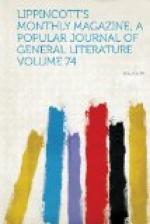“That was a very good sight in its way,” said Mr. Parker, “but we can hardly hope to compete with the sun, my dear: he has all his materials within himself, and we have to pay for them.”
“Do you know, Miss Ormiston,” said Mrs. Parker, “one of the buildings they said had such a fine effect put me in mind of a trunk studded with brass nails—the initials of the happy pair in gas-jets looked like the name of the owner of the trunk. All the time I was on the street I could not get that notion out of my head; and I was sorry, for I am sure it cost a great deal of money to light it up, and I really wished to think it grand.”
“We were all in town that night,” said John Ormiston—“papa and mamma, and the whole of us, and Mr. Forrester, who made eight.”
“I thought it a beautiful sight,” said Bessie.
“I never enjoyed anything more in my life,” said Mr. Forrester, who on that occasion had been Miss Ormiston’s escort through the streets, in which they lost their party, and had the supreme bliss of wandering together in the crowd, when Mr. Forrester almost forgot that Miss Ormiston was a goddess with five thousand earthly charms, and Miss Ormiston had compared his merits as a guide and protector with those of her brothers, and found he was much more considerate, and made her wish law, which they were often far from doing. In point of fact, a thaw had been very imminent, but, alas! since then a sharp frost had set in between them, as unaccountably as frosts frequently do set in.
“I think, now,” said Mrs. Parker, “a fine old castle like this ought to have had a grander name: don’t you think so, Miss Ormiston?”
“Yes, I do, and it had, originally. There was a monastery here at one time, over in that field with the trees in the corner of it: it was called the abbey of Cakeholy, and when the castle was built it got the name of Cakeholy Castle, after the abbey. The name Cakeholy, tradition says, arose from the fact that an extraordinary saint, whose wants had been relieved at the monastery, blessed all the bread that should ever be baked there, and the bread ever after had a great sustaining power in it; so that pilgrims from Edinburgh and the North, going to the southern shrines, all passed this way to get themselves supplied with the holy cakes. At the Reformation the abbey was destroyed, and became a ruin haunted by owls, so that, partly in derision and partly as suiting the altered circumstances, the common people corrupted the name into Cockhoolet; and in process of time it was given to the castle also, and stuck to it. That is the history of a name which is certainly neither romantic, nor high-sounding.”




